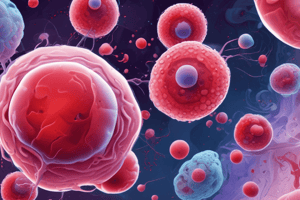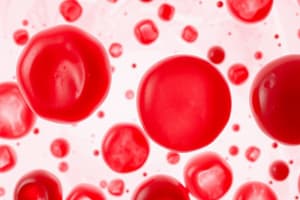Podcast
Questions and Answers
Red blood cells contain hemoglobin, a potassium-rich protein that binds to oxygen, giving blood its red color.
Red blood cells contain hemoglobin, a potassium-rich protein that binds to oxygen, giving blood its red color.
False (B)
Plasma constitutes approximately 75% of blood volume and includes water, proteins, electrolytes, hormones and nutrients.
Plasma constitutes approximately 75% of blood volume and includes water, proteins, electrolytes, hormones and nutrients.
False (B)
Platelets, also known as thrombocytes, are cell fragments crucial for blood clotting, initiating the formation of a platelet plug when blood vessels are damaged.
Platelets, also known as thrombocytes, are cell fragments crucial for blood clotting, initiating the formation of a platelet plug when blood vessels are damaged.
True (A)
The systemic circulation carries deoxygenated blood from the left ventricle to the tissues throughout the body.
The systemic circulation carries deoxygenated blood from the left ventricle to the tissues throughout the body.
Arteries have thinner walls than veins and contain valves that prevent backflow of blood.
Arteries have thinner walls than veins and contain valves that prevent backflow of blood.
People with blood group AB have neither A nor B antigens on their red blood cells, but they do possess both anti-A and anti-B antibodies in their plasma.
People with blood group AB have neither A nor B antigens on their red blood cells, but they do possess both anti-A and anti-B antibodies in their plasma.
Leukemia is a genetic bleeding disorder caused by a deficiency of certain clotting factors.
Leukemia is a genetic bleeding disorder caused by a deficiency of certain clotting factors.
The heart consists of three chambers: the right atrium, the left atrium, and a single ventricle.
The heart consists of three chambers: the right atrium, the left atrium, and a single ventricle.
Eosinophils are involved in allergic reactions and parasitic infections.
Eosinophils are involved in allergic reactions and parasitic infections.
The lifespan of red blood cells is approximately 120 days, after which they are removed from circulation by the kidneys.
The lifespan of red blood cells is approximately 120 days, after which they are removed from circulation by the kidneys.
Flashcards
What is Plasma?
What is Plasma?
The fluid part of blood, mainly water, carrying cells, proteins, electrolytes, hormones & nutrients.
What are Red Blood Cells (Erythrocytes)?
What are Red Blood Cells (Erythrocytes)?
Cells that carry oxygen from the lungs to the body's tissues, containing hemoglobin.
What are White Blood Cells (Leukocytes)?
What are White Blood Cells (Leukocytes)?
Immune cells defending the body against infection and disease, like neutrophils, lymphocytes, monocytes, eosinophils & basophils.
What are Platelets (Thrombocytes)?
What are Platelets (Thrombocytes)?
Signup and view all the flashcards
What is the Circulatory System?
What is the Circulatory System?
Signup and view all the flashcards
What are Arteries?
What are Arteries?
Signup and view all the flashcards
What are Veins?
What are Veins?
Signup and view all the flashcards
What are Capillaries?
What are Capillaries?
Signup and view all the flashcards
What is Systemic Circulation?
What is Systemic Circulation?
Signup and view all the flashcards
What is Pulmonary Circulation?
What is Pulmonary Circulation?
Signup and view all the flashcards
Study Notes
The provided text is identical to the existing notes. Therefore, no new information will be added, and the existing notes remain unchanged.
Studying That Suits You
Use AI to generate personalized quizzes and flashcards to suit your learning preferences.




